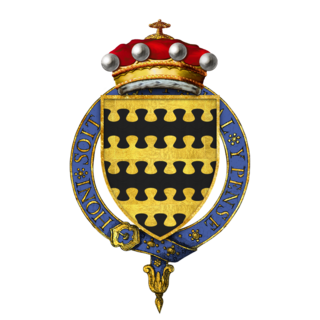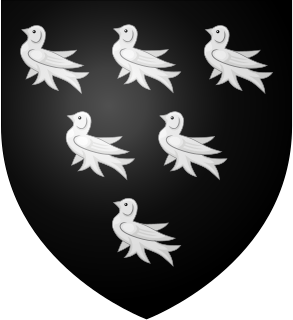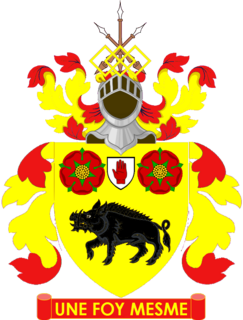Related Research Articles

William Blount, 4th Baron Mountjoy, KG, of Barton Blount, Derbyshire, was an extremely influential English courtier, a respected humanistic scholar and patron of learning. He was one of the most influential and perhaps the wealthiest English noble courtier of his time. Mountjoy was known internationally as a humanist writer and scholar and patron of the arts.
Sir William Laxton was a Lord Mayor of London during the reign of Henry VIII, and eight times Master of the Worshipful Company of Grocers. He is the founder of Oundle School.
Charles Blount, 5th Baron Mountjoy was an English courtier and patron of learning.

The Guild Church of St Mary Aldermary is an Anglican church located in Watling Street at the junction with Bow Lane, in the City of London. Of medieval origin, it was rebuilt from 1510. Badly damaged in the Great Fire of London in 1666, it was rebuilt once more, this time by Sir Christopher Wren; unlike the vast majority of Wren's City churches, St Mary Aldermary is in the Gothic style.
William Mauduit, 8th Earl of Warwick or William Maudit was an English nobleman and participant in the Second Barons' War.
Anthony Abdy, was a citizen and East India merchant of London. On the death of his father in 1595 he inherited lands at Colliers Row, Havering atte Bower, Essex and property in Red Lion Gate, London.

Sir Edmund Shaa or Shaw was a London goldsmith, Sheriff of London in 1475 and Lord Mayor of London in 1482. Shaa lent money to Edward IV and, as mayor, was extensively involved in the coronation of Edward IV's brother Richard III. He was later knighted and made a member of the Privy Council.
Sir Thomas Allen, 1st Baronet also spelt Aleyn or Alleyn, was an English politician and grocer.

Sir John Port was an English landowner and Knight of the Order of the Bath who served occasionally in the House of Commons. He was Sheriff of Derbyshire in 1554. By his will, he founded Repton School and almshouses at Etwall.
Ralph Crepyn was a lawyer and the first documented Town Clerk of London in 1274. His birth was about 1245, and he was well-educated for his day. He died before 1331, but the exact date is unknown.

Sir John Arundell, of Trerice in Cornwall, was a Member of Parliament for Mitchell, Cornwall, in 1555 and 1558, and was High Sheriff of Cornwall in 1573–1574.

Sir James Sanderson, 1st Baronet was a banker, a member of parliament, an alderman and Lord Mayor of London. He also served as president of Bridewell Hospital, and was a member of William Wilberforce's Proclamation Society for the Discouragement of Vice.

Sir Richard Thomas Gilpin, 1st Baronet was an English Conservative politician who sat in the House of Commons from 1851 to 1880.
Sir Thomas Lodge, was Lord Mayor of London.
John Barker was an English merchant and politician who sat in the House of Commons in 1659.
Thomas Browne, of Betchworth Castle, Surrey, was an English politician.
John Browne, of London and Horton Kirby, Kent, was Warden of the Mint and MP for Aldborough.

Sir Maurice Berkeley of Bruton in Somerset and of Berkeley House, Clerkenwell, Middlesex, served as Chief Banner Bearer of England to Kings Henry VIII, Edward VI and to Queen Elizabeth I and rose rapidly in the Tudor court. He came from a cadet branch of the great Berkeley family of Berkeley Castle in Gloucestershire, but in his career his initial advantage was due to his mother's second marriage to Sir John FitzJames, Lord Chief Justice of the King's Bench 1526–1539, which by 1538 had brought him into the household of Thomas Cromwell, from which he passed into the royal household by 1539.
Sir Richard Baker, was an English politician.
Sir William Browne served as Master of the Worshipful Company of Mercers from 1507 to 1514, and as alderman, auditor, Sheriff and Lord Mayor of London. He died in office on 3 June 1514 while serving his term as Lord Mayor.
References
- Brown, James Roberts (1888). "Jno. and Wm. Browne, Sheriffs and Lord Mayors of London". Notes and Queries. 7th. London: John C. Francis. V: 151–3. Retrieved 5 July 2013.